Guest Author – 2018 Student Summer Vegetable Garden Coordinator

In one of the new positions of Student Summer Vegetable Garden Coordinator (or as a friend of Scott Arboretum likes to call us, “farm hands”) I had eleven-and-a-half weeks of full-on vegetable garden emersion. It was enough emersion to proudly declare that I do not know everything, but I may offer personal key insights that I am certain will be of some benefit and may bolster visitors’ knowledge on (usually) successful crop-raising. These are some of my field notes…
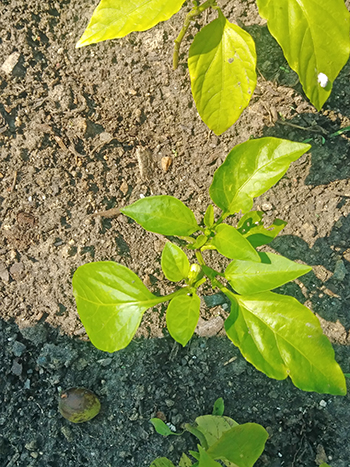
This pepper plant, Capsicum annum, does NOT need water and is currently enjoying a dry period. photo credit: K. Tindle
#1 Watering in Cycles: Not too soon, not too little, not too late (before wilting) …
One of the first assurances of job responsibilities was the necessary task of watering. I am so grateful Sue MacQueen, my boss (Community Outreach Coordinator), went beyond generalizing on this important, yet mundane task. On the first day, Sue explained how plants tell you “I’m thirsty” before wilting. For many plants, a subtle change in leaf complexion to a slight greyish sheen, which occurs before a plant becomes wilted, is enough indication to water. On the spectrum of dehydration, wilting is the more serious stage, and it is quite good when you can water before then.
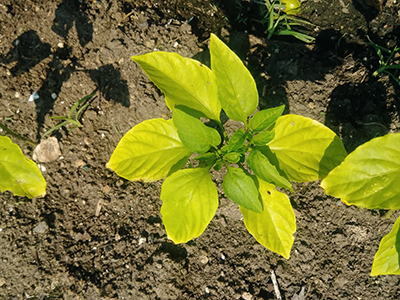
For many plants, a subtle change in leaf complexion to a slight greyish sheen, which occurs before a plant becomes wilted, is enough indication to water as seen in this pepper plant, Capsicum annum. photo credit: K. Tindle
Now, with this information, someone like me would be compelled to gander that we should “water, water, water!” Incorrect. We should not incessantly water our beautiful crops. Watering is even less subjective than the suggestion to not “overwater”. Plants not only need to be watered, they need to be able to dry out their roots, which is a process that takes time on its own. A great rule of thumb is to submerge your thumb into the plant soil. If you are feeling dryness at an inch depth, it is likely time to water again. Water, drain, dry, repeat.
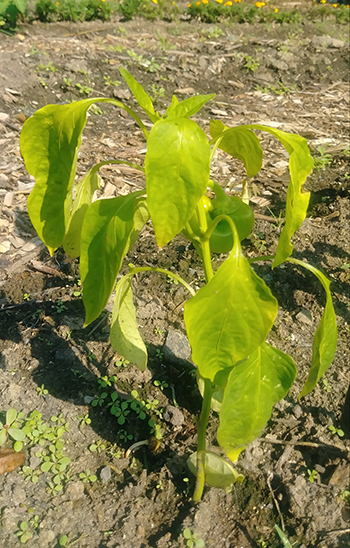
On the spectrum of dehydration, wilting is the more serious stage, and it is quite good when you can water before wilting as seen in this wilted pepper plant, Capsicum annum. photo credit: K. Tindle
Take home: think of watering as a process that happens in cycles, with various factors that influence how long a stage (watered, draining, or dry) in the cycle your plant stands. Remember also that age and activity of the plant (i.e. if it is currently producing fruit) also influence how much water and the frequency of watering required.

Student Summer Vegetable Garden Coordinators, Matthew Lucker and Kayonna Tindle, prepare to distribute the harvest. photo credit: S MacQueen
#2 A Right Time to Harvest
Ok, so you have already been masterfully watering your plants; perhaps this next tidbit will serve as a helpful harvesting reference. Now that you have raised delectable, plump, juicy crops, let’s capture them at their peak juicy, plump goodness. When it comes to harvesting, it is worth getting up bright and early (or in our case around 9AM) to harvest vegetables (and other crops) that are at their prime plumpness.

A harvest of cucumbers from the Good Food Garden. photo credit: S. MacQueen
Why not sleep in and harvest later? Well, because plants love their stages, and there’s one for this aspect of crop raising too. Over the course of each day, plants will begin the day plump and perky with sufficient water content. As the day continues on, plants become less plump and begin to shrink. By the blazing afternoon, a harvest may mean losing out on enjoying your crops in their prime.

Spacing is an important element for a successful food garden. photo credit: S. MacQueen
#3 Spacing: To have or not to have, and how many seeds to sow
So you have reached the point where you really just wish you had Chioggia Guardsmark beets or rainbow chard to jazz up your home-grown salad. If you’re like me and take packaging spacing guides as purely suggestions, let me tell you, there IS a time to closely adhere to. For example, think about spacing when you are holding that Beta vulgaris packet in your hand. Root vegetables, such as beets, should be given the soil space they need to not just grow up, but also grow out to have a nice, healthy diameter, instead of being undersized due to crowding. Would you rather have a state-fair winner sized beet, or a premature beet the size of a quarter?
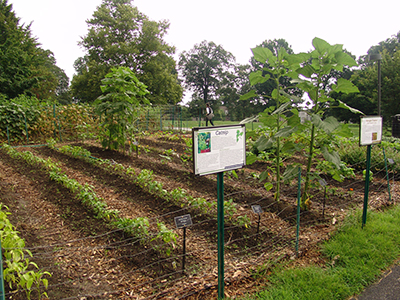
Save bulky, tighter-spaced planting for the small leafy guys, NOT for the root vegetables. photo credit: R. Robert
Oh wait, is that a Beta vulgaris sp. vulgaris seed in your hand? Let’s not be generous about spacing with this one. Smaller (not Brassica sized roots) leafy vegetables do not need to grow out very much, and generally are fine being planted in slightly closer spacing (but not too close of course). While you want there to still be space, it is ok to chuck one or two seeds in a hole and then follow up with a hole just two or so inches later.
Save bulky, tighter-spaced planting for the small leafy guys, NOT for the root vegetables.
Pop Quiz: Oy…which one’s beet and which one’s chard (see image below)?

Pop Quiz: Which one’s beet and which one’s chard? photo credit: K. Tindle
#4 The irrepressible, incorrigible, destructive Harlequin Bugs, and how to avoid a living nightmare

Please do not be deceived by their beauty; the moment you see these deep orange, black, and white spotted bugs, know that terror may await you and your crops. photo credit: K Tindle
The season has progressed and so have the advance of various insects. This is to be expected. What may not be expected is a horde of bugs seizing your mustard greens, collards, brussels sprouts, broccoli, and cauliflower. Please do not be deceived by their beauty; the moment you see these deep orange, black, and white spotted bugs, know that terror may await you and your crops. These Harlequin bugs have been the star pests of our garden for several reasons, starting with what attracted them to our garden.
Attraction of harlequin bugs to crops (typically with Brassicas in the summer) occurs when the crops are heading out of their season. These bugs with intense orange or deep mustard-yellow and symmetrical black and white marks were ever present, grasping onto stem after stem of our mustard green shoots. They are not just another spotted insect coming a bit late to visit your mustard greens in July. No, these bugs are on a stake-out of your garden, and those going-out-of-season mustard greens are the light house signal beckoning them to dock both on and in your Brassicas. And so, the saga of the harlequin infestation progressed for us as long as we had a single Brassica crop in the ground. The characteristic yellow spots and the aged, lifeless, tacky appearance of the leaves appeared on what were then infested row upon row of late-blooming Brassicas.
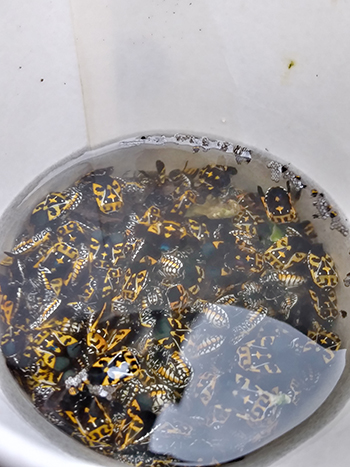
A cup of stout and (even better) 70%. rubbing alcohol with harlequin bugs. photo credit: K. Tindle
After multiple cups of stout and (even better) 70%. rubbing alcohol for plucking in several rows of aggressively mating harlequin and their barrel-shaped larvae from one leaf to the next, we realized we were only scratching the brim of the infestation. And while we were scratching the surface, the bugs had already bored into our brussel sprouts, the one crop that was just beginning to fruit.
Final verdict: Since we did not have a treatment plan long ahead of time, we were not prepared to protect our pest-prone late Brassicas. Our only resolve was to compost them with their parasitic bugs along for the ride.

Did someone say beetle juice? (Yes harlequins are bugs and not beetles) photo credit: K. Tindle
Fun Facts:
- Did someone say beetle juice? (Yes harlequins are bugs and not beetles)
- The term harlequin actually refers to a comedic character in the harlequinade with diamond-printed tights and colorful costume.

Student Summer Vegetable Garden Coordinator, Kayonna Tindle, elaborates on the benefits of vegetables to a harvest recipient. photo credit: S. MacQueen
#5 Incredible edibles, the hidden gems that are self-establishing “crops”
After all that warning feel free to take a deep breath and give a sigh of relief. You really dodged a disaster there. Now for some sprightliness about vegetable crop growing…
…As someone who is emphatic about alternative medicine and realizing the many avenues to nutrients that lie in our plant life, perhaps one of the sweetest treats in our vegetable garden was the often-overlooked, tossed away hidden gems that appeared and thrived in our garden plots quite readily. Yes, I am describing what we haplessly consider weeds.
As much as we understand “weeds” to be the plants that are simply undesired or unattended for a specific location, in the case of a food crop plot, the term weed can be quite blinding. Plenty of plants that are “weedy” or self-establishing by nature, such as dandelion, purslane, or even purple basil, have the ability to both fill plates and gaps in nutrition that are ever-present in the American diet.
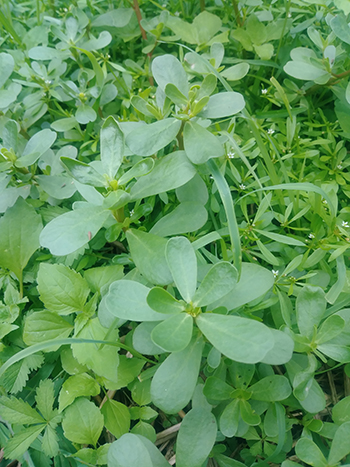
An herb in the succulent family that can be often spotted in your backyard, Portuloca oleracea is incredibly nutritious in ways that the conventional crops you’ve toiled over so much are certainly not. photo credit: K. Tindle
Purslane is the latest prime example from our vegetable gardens. An herb in the succulent family that can be often spotted in your backyard, Portuloca oleracea is incredibly nutritious in ways that the conventional crops you’ve toiled over so much are certainly not.
Purslane, otherwise known as duckweed or pursley, contains Omega-3 (generally sought from fish oil), the natural and cholesterol-lowering thickening agent “pectin”, one of the highest levels of vitamin A of common leafy greens, vitamin C, and important minerals including magnesium, copper, iron, and potassium.

Student Summer Vegetable Garden Coordinators, Kayonna Tindle and Matthew Lucker, working in the Good Food Garden. photo credit: S. MacQueen
Even better, this powerhouse of a crop has a taste akin to watercress and is versatile in its use in accordance with the maturity of the plant. Young tender leaves and stems are superb for salads while fully-grown leaves and non-central stems are favored for being even more nutrient-rich and as a non-oily thickening solution for pesto. Balance is key for this herb, as it also contains high levels of oxalates (similar to spinach) that can increase the risk of kidney stone formation when enjoyed too much. In all, sometimes it’s ok to not plant the crops, but let the crops come to you.
